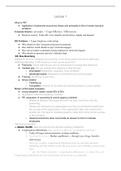Lecture 1
What is PE?
● Application of personnel economics theory and principles to firm's human resource
problems
Economic theories / principles → Target Efficiency / Effectiveness
● Resource scarcity, Trade-offs, Cost, benefits and incentives, Supply and demand
HR Problems → Target Employee relationship
● Who should we hire? (attraction/selection/recruitment)
● How and how much should we pay? (motivate/engage)
● How can we induce cooperation among employees? (motivate/engage)
● Who should we promote and why? (train/develop)
EX: Bus Bunching
Waiting for the bus, suddenly bus bunching. 3 bus drivers paid to be at the same time.
Inefficient allocation of HR resources. How can we solve this?
● Fixed pay: Those with this pay are not incentivized to change their behaviour
● Variable pay: We can change their behaviour using this pay
○ time-based: Drawbacks: speeding, more accidents
○ passenger-based: Drawbacks:no schedule, bus bunching again
● Training: still having to pay them
● Group solution
○ Teaming up:
○ Competition: rewards for the least bus bunching based on a line number
History of Personnel economics
● young discipline, classic routes 80's & 90's
● developed in German-speaking countries
● PE: separation of ownership & control (agency problem)
○ difference between the people who own the place and those who are
performing
○ People are working for an organization and they do not directly benefit from
the success of the organization. If the organization fails, they need to find
another job. We need to motivate people to make them strive for the success
of the company.
○ classical economics does not provide an answer to how to motivate
employees
Classical economists:
→ Adam Smith (take into account the physical working conditions!)
● Compensation differentials (when you have a shitty job, you should be paid more)
○ Trade-off wages and non-monetary working conditions
○ Restoring this balance: Market equilibrium → through: pay, fringe, benefits,
deferred pay
○ However, in reality, compensating differentials does not mean that extremely
demanding jobs like military receive the most money since footballers receive much
more
■ The Wealth of Nations → compensation differentials, is it always the case?
Compensating differentials does not work because labour-power is a commodity!
,→ Karl Marx Wage Labour & Capital (wage is subjective to the economic conditions)
● Labor-power (wage is a subject to economic conditions)
○ is a commodity: working in a supermarket as a student = selling free time to the
supermarket
○ with a monetary exchange value (wage)
● “labor-power is commodity which its possessor, the wage-worker, sells to the capitalists”
● The same general laws which regulate the price of commodities regulate wages
● Supply & demands play role (that's why a footballer has a high pay)
According to Marx & Smith, employees of Jumbo and Aldi should be earning the same as they are
doing the same jobs as the sector, physical conditions and type of work is the same. Lazear
investigates this with rigorous theory.
→ Lazear - Traditional production theory
● Agency problems
○ Traditional (labour) economics
■ external labour market (labour supply & demand)
○ Personnel economics
■ Internal labour markets (Administrative rule, mechanisms about how HR is
made)
Key characteristics of Personnel economics:
1. Employees and organizations are rational maximizing agents
● consider available information (probabilities, costs, benefits)
● make individual choices
● act coherent (making the same choices all over again)
EX: choosing a post-grad job
Nevertheless
● imperfections (making choices doesn't mean we have all the information, transaction
costs)
● No single best solution (best fit vs. best practice)
EX: Glassdoors (supplying as much as possible info about organizations)
2. Employees and organizations want to maximize (homo economicus)
● homo economicus: rational and utilitarian
● focus on monetary compensation or monetary equivalent
- not only focused on your wage but also on different benefits
Recently: idea of homo economicus has been challenged. Homo reciprocans. Ppl are also
motivated by the following!
● intrinsic motivation
● fairness considerations
● equity/quality
But: personnel economics still assumes the above stated can be transferred into money.
homo Liking your job → less stress → less health risks → less costs for health
3. Assumption of market equilibrium
Talking about money does not mean it is only organizational view, it assumes that when
employees in organizations interact, there is a away to pay them money they are satisfied with
while the organization has a sufficient performance = balanced approach
● wants/welfare employees and organizations satisfied
, ● HRM: Balanced approach (happy productive worker, satisfied employer)
● Idea: action & reaction (<-> psychology)
Limits
SHRM model:
● Focus on Competitive mechanisms (product, market, technology, context) but not on:
● Heritage mechanisms (structure systems, org, culture, human capital)
○ Operating in one industry for a long time, difficult to change
● Social/Political/Cultural/Legal practices
○ Swedish Fika (not viable from a financial point of view despite productive benefits) ,
Japanese Nemawashi (not viable because why to have informal decision making
before formal decision making?), Performance appraisal (yearly evaluation talk is not
functional, it is better to get continuous feedback)
○ Law: collective bargaining agreements, trade unions
Strengths! (Dilger paper)
● theoretical and methodological foundation (connections to econ, mathematics, law, sports,
psychology and sociology)
● rediscovered personnel costs
Lecture 2
This lecture originates from the characteristic of separation ownership and control
1. The problem
Payment:
● How much? how? contingency of an outcome? before/after? → what is the
way to make an arrangement between two parties?
Principal-agent problem: best way to structure and arrangement between two parties
1. Principle offer employment contract
15/h + 100 bonus for completing a task
Backwards induction: predict response?
2. Agent/ Employee accepts or rejects contract: the participation constraints
3. Agent picks effort, determining Q = revenue. The incentive compatibility constraint
alternatives = the expected outcome of the contract is better than the alternatives
● how much effort an agent/employee puts into work determines the output/revenue
4. Agent is paid and profits are realized
Welfare of the principle is profit
profit = revenue (Q) - costs (Y)
● principal invests costs, gets revenue
Welfare of the agent is utility
welfare = utility - effort
● However, effort is a commodity and
is costly. In the morning, it is easier
to study for an exam than during an all nighter (we need to invest more
effort during an all nighter) → Increasing marginal cost displayed in Disutility-
effort function (V(E))
, ○ relationship between effort and cost is non-linear, so we cannot invest the
same effort but we need to invest more energy later in the time
● 4-day work-week (we need to invest much more effort
on Friday)
● choice of contracts w/ more income for less effort
(earning more while doing less) → increase in Utility
○ choosing to work for Jumbo during the day than
for a night bar during the night
2.The solution to the problem
= agreement specifying terms and conditions under which a person consents to perform certain duties
as directed and controlled by an employer in return for an agreed upon wage or salary
1. Job description: V(E) = efforts or what the employee has to do
2. Compensation: Y = a + b x dE (base pay a + variable pay)
● base pay: a
● incentive pay: b (also piece rate, commission rate)
○ depends on performance: Q
○ which is a function (Q(E)) reflecting differences (d) in Effort (E): dE
→ if my base pay is 2k eur and it is not dependent on how much I sell, a = 2k, b = 0
→ if my base pay is 1k and for every product I sell I get 500 (dE), and I want to make 2k,
I need b to be 2
→ entirely on my performance: a = 0, b = higher
This gives rise to 3 types of contacts:
1. Pure wage labour
● fixed pay (a≠0)
● no incentives (b=0)
● office workers, performance invisible
2. Share contracts
● agent and principal share
● bartender in Europe: base pay (positive a) + tip money (variable b, depends on performance)
3. Rental contract
● agent pays/invess (a < 0 → fixd pay a is zero or even negative)
● agents get a larger share of revenue (b = 1or 100 %)
● deliveroo driver: paid per delivery, no base pay (needs to make investments in bike and
phone)







